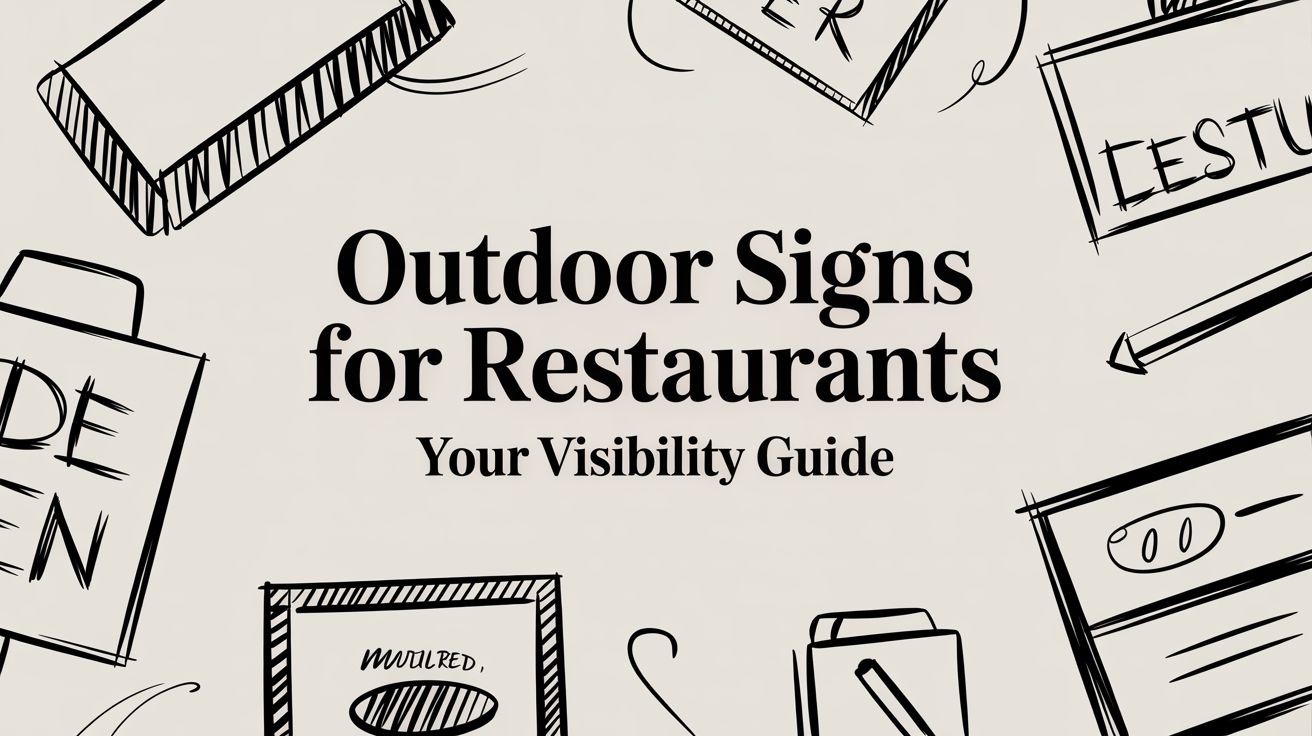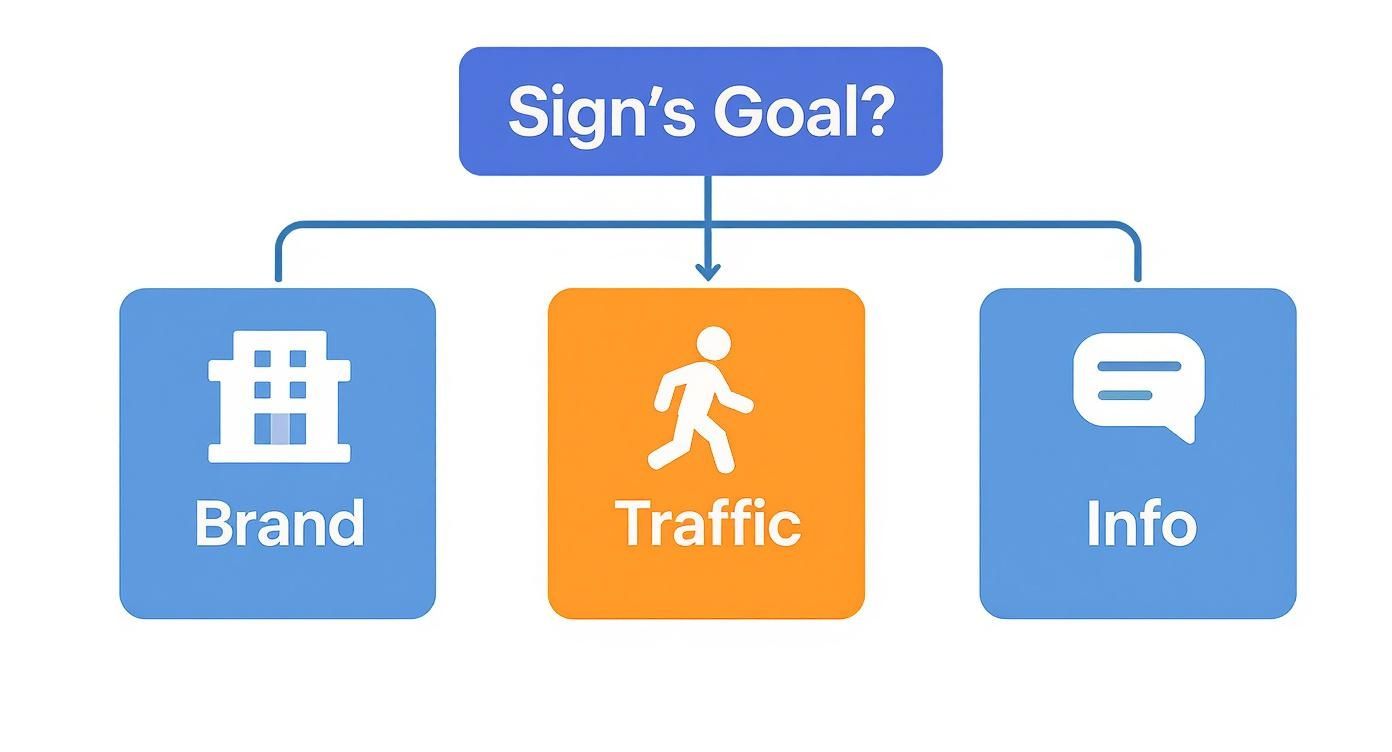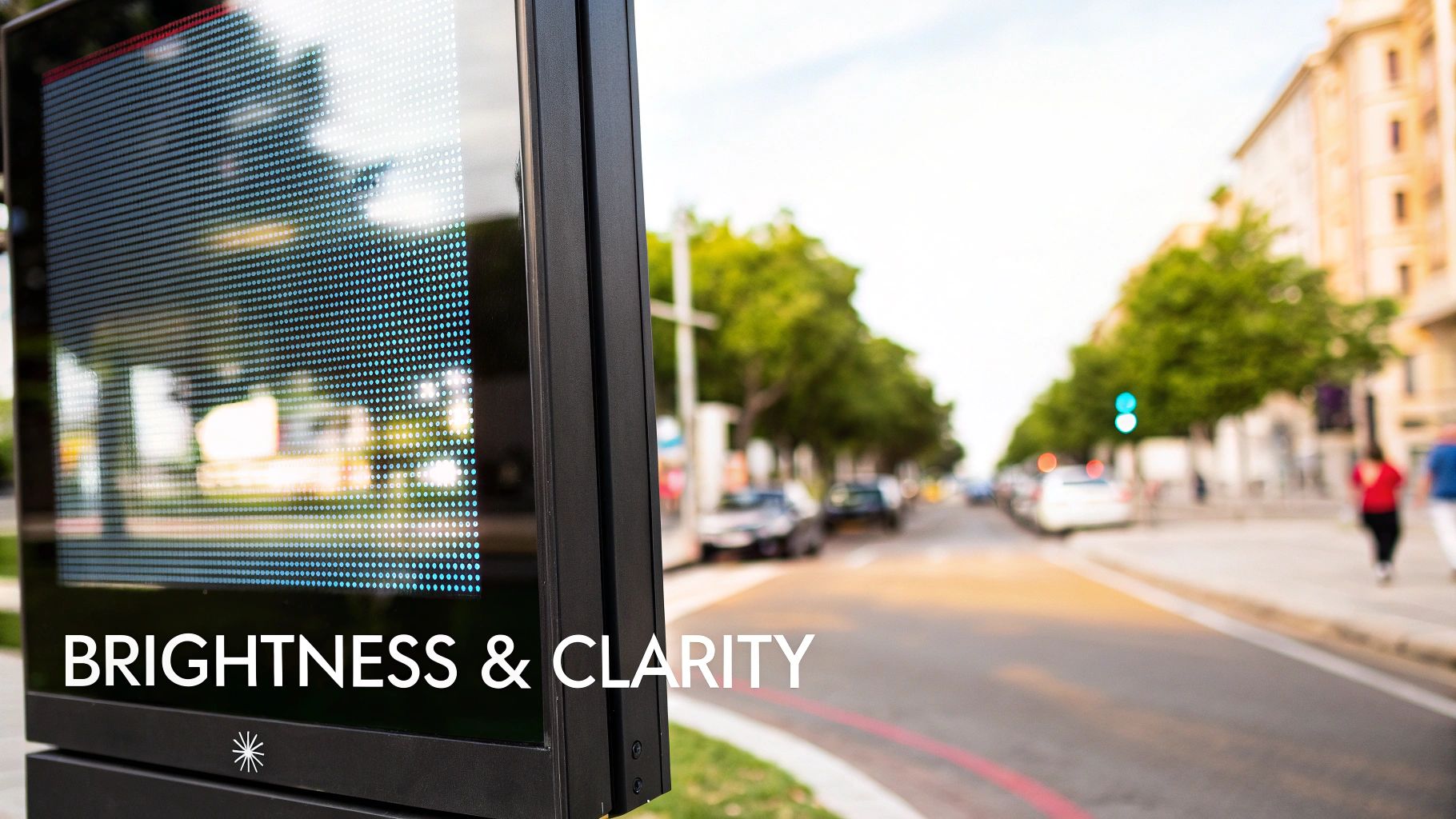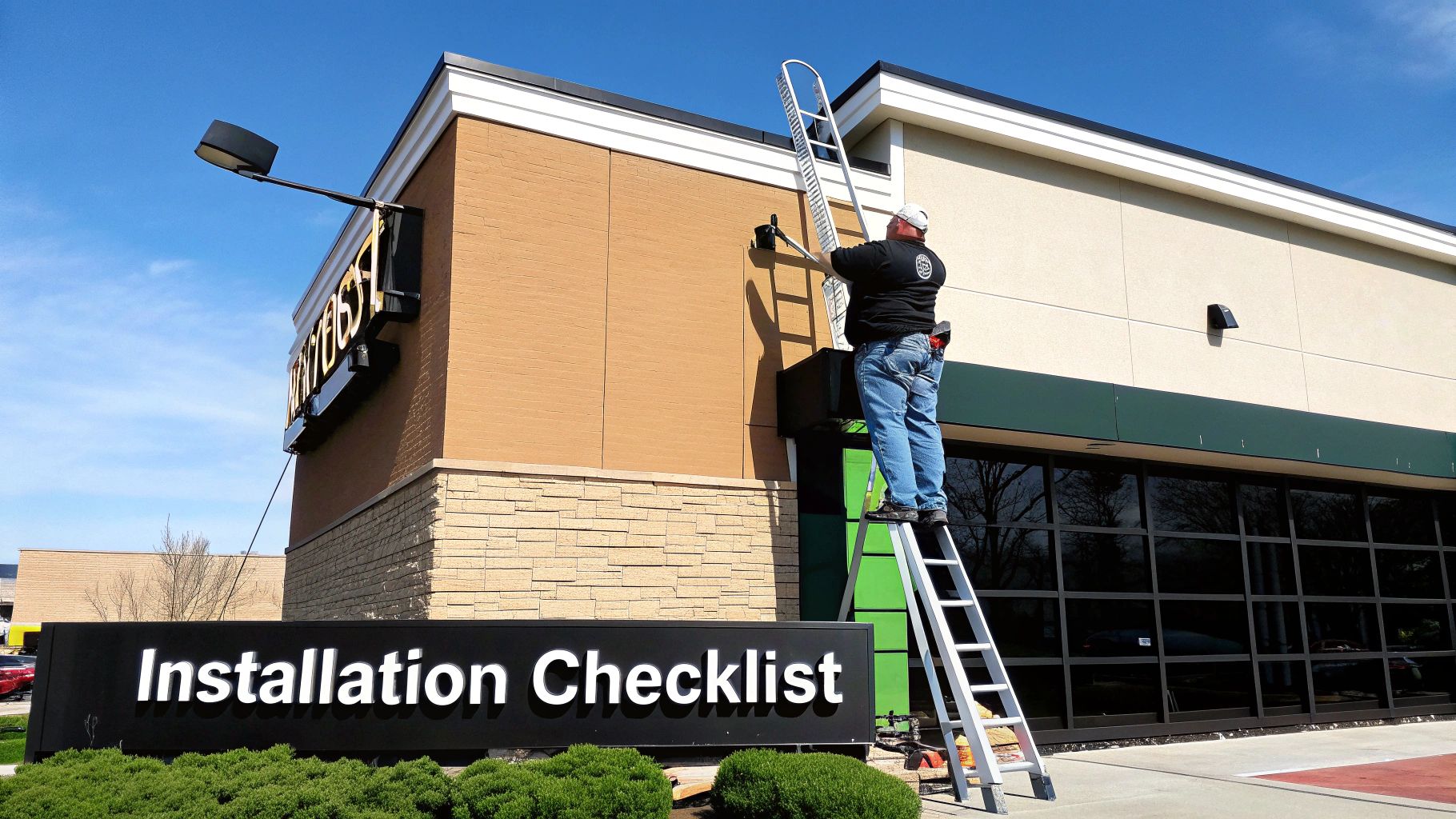
Ultimate Roll Up LED Display Guide
A roll up LED display feels like a high-resolution screen you can stash in a poster tube. In a few seconds, it unfurls into a

Your restaurant's outdoor sign is its most powerful, nonstop salesperson. It’s out there 24/7, grabbing attention and telling your story to everyone who drives or walks by. Think of it as the very first handshake with a potential customer—it sets the stage for the food, the service, and the entire vibe they'll find inside.
A great sign is often the only thing separating you from the restaurant next door. It's the difference between being the place everyone notices and the one they just pass by.
Imagine your sign as the cover of a book. A bland, generic cover suggests a pretty boring story, right? But a vibrant, well-designed one makes you want to crack it open and see what’s inside. In the dog-eat-dog restaurant world, that split-second judgment is everything. Your sign isn't just a marker; it’s a make-or-break marketing tool that defines who you are and pulls people in off the street.
The right sign acts as a silent ambassador, broadcasting what makes you special. A rustic, hand-carved wooden sign might instantly say "farm-to-table goodness," while a sleek, minimalist metal sign screams "high-end, modern dining."
Long before anyone takes a single bite of your food, your sign has already shaped their opinion. A faded, peeling, or just plain boring sign can signal a lack of care, turning away diners who might wonder if that same attitude applies to the kitchen.
On the flip side, a sharp, well-maintained, and thoughtfully designed sign builds instant trust. It tells the world you’re a professional, you’re proud of what you do, and you care about the details. That perception is incredibly powerful and often decides whether a curious glance becomes a paying customer.
It's not just a hunch. One study found that over 76% of consumers admitted to walking into a business they'd never visited before based on its sign alone. That's a massive testament to the power of strong visual branding.
The type of sign you choose plays a huge role in the story you tell. Each one has a different personality and job to do:
To really turn your restaurant's exterior into a customer-magnet, it's worth digging into the principles of mastering store signage design. At the end of the day, an investment in quality outdoor signage is a direct investment in your bottom line.
When it comes to your restaurant’s outdoor sign, you’re standing at a fork in the road. Do you go with a timeless, classic static sign or a dynamic, modern digital display? This isn't just about aesthetics; this decision will shape your budget, branding, and even your day-to-day marketing.
Think of it like choosing between a beautifully printed menu and a digital menu board. One is permanent, tactile, and classic. The other offers endless flexibility to highlight specials and update prices in an instant.
Neither is inherently "better." A static sign offers a rock-solid brand presence, while a digital sign gives you the agility to adapt on the fly. The right call comes down to your restaurant's personality, location, and what you’re trying to achieve.
This visual breaks down the decision-making process based on your primary goal.

As you can see, if your mission is to build a lasting brand identity, a static sign might be your best bet. But if you need to drive immediate traffic with daily specials, a digital display is the more powerful tool for the job.
Static signs are the tried-and-true workhorses of the restaurant world. They are your traditional, permanent fixtures, often crafted from materials that say something about your brand before a customer even steps inside. They are a one-time investment in your physical identity, creating a landmark people can recognize and remember.
Their power is in their simplicity and tangible presence. A beautifully carved wooden sign can instantly signal a rustic, farm-to-table vibe. A sleek, brushed metal sign, on the other hand, might suggest an upscale, modern dining experience.
Consider some of the most common materials:
Beyond your main sign, don't forget about other static options. Creative window graphics services can turn your entire storefront into a branding opportunity, catching the eye of every person who walks by. At its core, static signage is all about powerful, unwavering brand reinforcement.
Digital signs, almost always powered by LED technology, are the modern answer for restaurants that need to communicate quickly and effectively. They're the digital picture frames of the sign world, giving you the power to change your message with just a few clicks. This adaptability is their superpower.
Instead of being locked into a single, unchanging message, you can show off:
This kind of flexibility turns your sign into a game-changing marketing machine. The growth here is undeniable—the global hospitality digital signage market was valued at $2.48 billion in 2024 and is expected to rocket to nearly $4.09 billion by 2032. Why? Because 73% of diners actually appreciate tech-enhanced experiences. They want to see digital menus, promotions, and real-time updates.
An LED sign transforms your storefront from a static location marker into a dynamic, revenue-generating billboard. It allows you to test offers, promote high-margin items, and react instantly to sales patterns or inventory levels.
Choosing to go digital is an investment in a tool that grows with your business. For a deeper dive into what these displays can do, check out our guide on LED signs for businesses.
To help you weigh the pros and cons side-by-side, we've put together a quick comparison. Think of this as your cheat sheet for deciding whether to prioritize timeless branding or agile, in-the-moment marketing.
| Feature | Static Signs | Digital Signs |
|---|---|---|
| Initial Cost | Lower | Higher |
| Long-Term ROI | Brand recognition, lower maintenance | Higher traffic, direct sales lift |
| Flexibility | Low (message is permanent) | High (can be changed instantly) |
| Maintenance | Minimal (cleaning, occasional repair) | Regular (software, potential hardware) |
| Best For | Establishing a classic brand identity | Driving immediate sales with promos |
| Visual Impact | Depends on design and materials | High-impact with motion and brightness |
Ultimately, whether you choose a static sign that becomes a beloved local landmark or a digital display that keeps your messaging fresh and exciting, the goal is the same: to stop traffic and bring hungry customers through your doors. Your decision just comes down to which tool best fits your restaurant's unique voice and strategy.
Diving into the world of digital outdoor signs can feel like you're suddenly trying to learn a new language. You're hit with a barrage of terms like nits, pixel pitch, and IP ratings. But don't worry—getting a solid grasp on these core concepts is the key to making a smart investment that'll pay dividends for years to come.
Think of it like this: you wouldn't buy a new combination oven for your kitchen without understanding the difference between convection and steam. The same logic applies here. Knowing the tech inside and out empowers you to ask the right questions and pick a sign that will perform flawlessly for your specific location.

The first and most important spec you need to get right is brightness, which is measured in a unit called nits.
Picture trying to see your phone screen on a ridiculously sunny day. If the brightness isn't cranked all the way up, the sun’s glare makes it impossible to read. Your outdoor digital sign faces that exact same battle every single day.
A sign with a low nit rating will look completely washed out and unreadable in direct sunlight, which completely defeats the purpose of having it. For any outdoor sign, you should be looking for a rating of at least 5,000 nits. For locations that get blasted with intense, direct sun all afternoon, 7,000 nits or higher is the way to go.
A higher nit rating is what makes your food photos look mouth-wateringly vibrant and your happy hour specials perfectly legible, even at high noon. It's the single most important factor for daytime visibility, period.
Next up is pixel pitch. This is simply the distance between the center of one tiny LED light and the center of the one next to it, measured in millimeters (mm). Think of it like the resolution on your TV. A smaller pixel pitch (like 6mm) means the pixels are packed tightly together, creating a much sharper, higher-resolution image.
On the other hand, a larger pixel pitch (like 16mm) means the pixels are farther apart, which can look a bit grainy or "pixelated" up close. So, which one do you need? It all comes down to how far away people will be when they see it.
Choosing a pixel pitch that’s too large for your viewing distance is like buying a standard-definition TV in an HD world—it just won’t deliver the quality you're paying for. To get a better feel for how all these specs come together, it's worth exploring the different types of digital outdoor signage on the market.
An outdoor sign has to be tough. It must be built to withstand everything from pouring rain to baking sun and blowing dust. This durability is measured by an IP (Ingress Protection) rating. The first number rates protection against solids (like dust), and the second rates protection against liquids (like water). For any outdoor sign, you need a rating of at least IP65, which means it's totally dust-tight and can handle jets of water from any direction.
Finally, the real brain behind your sign is the Content Management System (CMS). This is the software that lets you upload images of your daily specials, schedule your happy hour ads, and change menu prices right from a computer or even your phone. A user-friendly CMS is non-negotiable. It’s what makes your digital sign a powerful, agile marketing tool instead of a frustrating technical headache.
The demand for this kind of dynamic control is exploding. The market for interactive outdoor digital signage hit about $1.935 billion USD in 2025 and is projected to grow at a 5.5% CAGR through 2033, largely because restaurants are looking for better ways to engage customers.
Few things can kill the excitement of a new sign faster than getting tangled in the dense web of local regulations. Before you fall in love with a design, you have to accept a hard truth: your city or county gets the final say. This isn't a friendly suggestion; it’s a legal hurdle meant to keep the public safe and maintain your community's look and feel.
Think of it like getting a permit for a new patio. You wouldn't just start pouring concrete in your backyard without getting the green light from the city, right? The same logic applies to your sign. Trying to sidestep this process is a recipe for disaster, leading to heavy fines, project-stopping delays, and maybe even the gut-wrenching order to tear down your beautiful, brand-new sign.
If you take only one piece of advice from this guide, let it be this: start the permitting process as early as possible. It's not the final item on your checklist; it should be one of the very first things you do. The timeline can be wildly unpredictable, stretching from just a few weeks in a small town to several agonizing months in a major city.
Weaving this into your plan from day one saves you from the nightmare scenario where your perfectly crafted sign is ready to install but is forced to collect dust in a warehouse while you wait for a stamp of approval. Your sign vendor is your best ally here. A good, experienced company has been down this road a hundred times and knows the local codes inside and out.
Here's the golden rule: Never pay a deposit or let fabrication begin until you have a signed, approved permit in your hand. This one simple habit can save you thousands of dollars and a world of frustration.
While the fine print varies from one town to the next, most zoning laws for outdoor signs for restaurants circle around the same core issues. Knowing what they are ahead of time will help you and your designer create a sign that’s not just stunning but, more importantly, approvable.
Most cities and counties will have rules on:
Is your restaurant nestled in a designated historic district? If so, get ready for an extra layer of review. These areas are governed by incredibly specific guidelines designed to preserve the unique architectural character of the neighborhood.
This often translates into tight restrictions on:
Getting a sign approved in a historic district can take much longer and often involves a formal review by a special architectural or historical board. It’s more complex, for sure, but following the rules ensures your sign becomes a beautiful part of your unique location instead of an eyesore. Tackling this regulatory maze is a non-negotiable part of choosing the right outdoor signs for restaurants.
It's a common trap to see an outdoor sign as just another line item on your expense sheet. But a truly great sign isn't a cost center—it's a powerful, revenue-generating asset that works for you 24/7. To make a smart financial move, you need to look past the initial price tag and focus on the real prize: your return on investment (ROI).
The first step is to wrap your head around the total cost of ownership. This gives you the full, unvarnished picture of what you're committing to financially, so there are no nasty surprises waiting for you down the road. It's about seeing the entire investment, from the first sketch to its ongoing performance.
That number you get on the initial quote? It’s just one piece of a much larger puzzle. To budget like a pro for your new sign, you need to account for all the critical components that make up the total cost.
These often-overlooked expenses can really throw a wrench in your financial plans if you're not prepared. A solid budget includes:
By mapping out all these elements, you can build a realistic budget that actually works for your restaurant. For a deeper dive into the numbers, you might find our guide on understanding outdoor LED sign costs helpful.
Once you have your budget dialed in, the conversation needs to change from "How much is this going to cost me?" to "What is this going to earn for me?" This is where the magic of ROI comes into play. A fantastic sign actively funnels money back into your business in more ways than one.
A vibrant digital sign, for instance, can do so much more than just display your restaurant's name. It becomes a promotional powerhouse that drives customers to act right now. Imagine flashing a special on a high-margin craft cocktail right as rush hour hits, or announcing a "kids eat free" night to pull in families on a typically slow Tuesday. That kind of marketing agility is something a static sign just can't deliver.
Your sign is a direct investment in customer acquisition. On average, adding a new sign or upgrading an old one can boost a business's sales revenue by 8% to 15%. It's one of the most effective marketing dollars you can spend.
In the restaurant world, this effect is even stronger. Digital menu boards can bump up the average sale per customer by 3% to 30% over static signs. Plus, you can see operational efficiency improve by up to 20% just by ditching printing costs. With projections showing over 70% of restaurant chains will be using digital signage for their outdoor operations by 2030, the trend is undeniable. You can find more insights on the growing restaurant digital signage market.
To truly see your sign as an asset, let's think about its direct impact on your bottom line. Let's play out a simple scenario. Say your new sign brings in just four extra tables of two people each day. If their average check is $25 per person, that’s an extra $200 in revenue every single day.
That one change adds up to over $70,000 in new sales over the course of a year. When you stack that number up against the initial investment, you'll often find the sign pays for itself in a matter of months, not years. Suddenly, the cost of outdoor signs for restaurants doesn't seem like a daunting expense anymore—it becomes a strategic, and highly profitable, investment.
Your new sign has been built, and the excitement is real. But let's not get ahead of ourselves—the job isn’t done just because the sign is ready. Proper, professional installation is the final, crucial step. It’s what ensures your investment is secure, safe, and works perfectly from the moment you flip the switch. This is absolutely not a DIY project; it’s a specialized skill that requires the right tools, training, and experience.
Think of it like the grand opening of your restaurant. You wouldn't let an amateur run the kitchen on the biggest night of the year, would you? Professional installers are the seasoned pros who guarantee your sign is presented perfectly to the world, protecting its performance and your brand's reputation.

Hiring a licensed and insured professional isn't just a good idea—it's essential for safety, compliance, and the longevity of your sign. An improperly installed sign is a huge liability. It can damage your building, fall and injure someone, or have sketchy wiring that becomes a serious fire hazard.
The pros know the specific structural demands for different mounting types, making sure every connection is rock-solid and weatherproof. They also handle the installation to code, which is almost always a requirement to pass the final city inspections.
A professional installation is your best insurance policy against future headaches. It protects your sign from premature failure due to weather stress and ensures all electrical components are safely and correctly configured, maximizing the lifespan of your investment.
A seamless installation actually begins before the crew shows up. A little prep work on your end ensures the process is quick, efficient, and free of delays that could cost you money.
Run through this simple checklist to make sure your site is ready to go:
Once your sign is up and shining, a simple maintenance routine will keep it looking brilliant for years. Just like any other piece of equipment in your restaurant, your sign needs a bit of regular care to perform at its best. Protecting your outdoor signs for restaurants is all about consistency.
A little proactive care goes a long, long way.
Digital displays need a little extra TLC to keep the technology humming along.
After digging into all the options, it's totally normal to still have a few questions rolling around in your head. I get it. This is a big investment in your restaurant's future, and you want to be sure you're making the right call. To help, I’ve put together direct answers to the most common questions we hear from owners just like you.
Think of this as the final conversation to clear things up, so you can move forward with total confidence.
The price tag on outdoor signs for restaurants is all over the map. On one end, you’ve got the simple, classic A-frame or sandwich board. These might only set you back a few hundred dollars and are fantastic for hitting the sidewalk with your daily specials right away. They have a friendly, approachable vibe that just works.
On the other extreme, a big, custom-built digital LED sign is a serious capital investment, often running into many thousands of dollars. The final cost really boils down to the size, technology, pixel pitch, and how complex the installation is. It’s best to see this as a long-term asset that generates returns, not just another line-item expense.
If you're in a dense, walkable neighborhood, your number one job is to turn heads and pull people in off the sidewalk. For this, you need signs at eye level that can shout a timely, compelling message. That's what converts a passerby into a paying customer.
Think about this: A FedEx Office study found that 68% of consumers believe a business's sign reflects the quality of its products. When it comes to foot traffic, that means a sharp, engaging sign is your best handshake—it makes a great first impression and gives people a reason to walk through your door.
Ah, the million-dollar question. This is easily the biggest variable in any sign project. Getting a permit can be a breeze, taking just a few weeks in a smaller town, or it can be a months-long marathon in a big city or a special area like a historic district.
A few things will affect your timeline:
The golden rule is to start the process as early as humanly possible. Get your sign vendor and the local planning department talking on day one. Understanding their specific rules and timelines upfront is the single best way to avoid maddening—and expensive—delays down the road.
Ready to transform your restaurant's visibility with a display that stops traffic and puts more customers in seats? The team at Smart LED Inc. offers factory-direct pricing on premium outdoor LED signs built to do just that. https://smartledinc.com

A roll up LED display feels like a high-resolution screen you can stash in a poster tube. In a few seconds, it unfurls into a

So, you're thinking about a video wall. The big question on everyone's mind is always: what's this actually going to cost? The honest answer is,

Think about the walls around you. For most of history, they’ve been static, passive surfaces. But what if a wall could come alive? What if
"*" indicates required fields